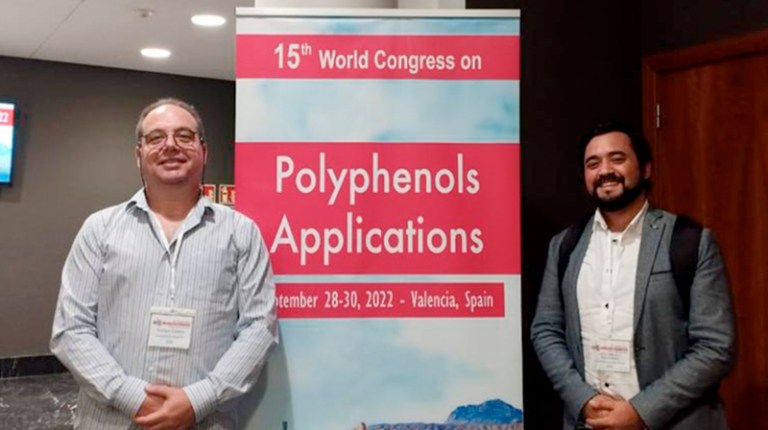Gustavo Cabrera and Danilo Escobar, principal researcher and post doctoral researcher respectively of UDT and CENAMAD in the area of bioproducts, presented two papers at this congress, aimed at obtaining phenolic compounds from tree bark.
The principal investigator of the National Center of Excellence for the Wood Industry (CENAMAD) and the Technological Development Unit (UDT), Gustavo Cabrera, together with post-doctoral researcher Danilo Escobar, represented the center at the 15th World Congress on Polyphenols Applications 2022, held between September 28 and 30 at ADEIT “Fundación Universitat” in Valencia, Spain.
This event, organized by the International Society for Nutrition and Health (ISANH), the International Society for Microbiota and the Scientific Committee, aimed to bring together experts from both academia and industry around the latest scientific advances in fundamental and applied research on polyphenols, including advances in the areas of nutrition, health, microbiology and biotechnology, among others.
UDT / CENAMAD researchers were able to participate in this event through two accepted papers, both related to sharing the progress of the Center’s bioproducts research line in the area of obtaining phenolic compounds from the bark of Pinus radiata and Eucalyptus globulus, both with high potential for biotechnological use.
The first of these investigations was presented by the principal investigator Gustavo Cabrera, entitled “Eucalyptus globulus bark as a source of polyphenols with potential biotechnological applications”. This work counted with the participation of other experts from the center, such as principal investigator Cecilia Fuentealba, associate researchers Pablo Reyes and Juan Pedro Elissetche and postdoctoral researcher Danilo Escobar.
This study aims to make visible the qualities in the area of biotechnology that the bark of Eucalyptus globulus, commonly known as Australian blue eucalyptus, of which there are currently 479,000 hectares planted in Chile, has to offer. In its processing, around 279,000 tons of bark are generated each year, which are currently used as biofuel.
Cabrera’s team observed in these barks a renewable and highly available biomaterial, which presents promising biological properties thanks to its phenolic composition. An extraction of polyphenols from the barks was carried out, and their effect as a controller of wood-staining fungi was evaluated through studies of solvent ratio, temperature and exposure time.
Thanks to this it was possible to arrive at various combinations of effective extracts, highlighting that the most active in their control task had a proportion of 70% of eucalyptus polyphenols and 21.5% of sugars.
The second study presented was “Green Alternative Technologies for Phenolic Compound recovery from Pinus radiata bark: a comparative study”, oriented to work with radiata pine bark and presented by Danilo Escobar. This research also included the participation of Gustavo Cabrera, Cecilia Fuentealba, Pablo Reyes, Juan Pedro Elissetche and the project manager of the bioproducts area, Victor Ferrer.
This project aimed to study the high content of phenolic compounds in the bark of radiata pine, the most common forest species in the country’s forestry plantations. For this purpose, an exploration of its multiple industrial applications was carried out through new extraction methods and agents that do not affect the condensed tannins of the material and improve its biological properties.
The objective of this study was to compare the recovery of phenolic compounds obtained in a conventional way, by solid-liquid extraction, with those extracted with new processes, such as ultrasound-assisted extraction (UAE) and the application of cyclodextrins (CD) as an extraction and protection agent.
Through this comparison, it was possible to determine the extraction yield of each system, the total content of phenols in each sample and their antioxidant activity. Among the results, it was possible to observe differences between the methods studied, being the most effective the combined use of cyclodextrins in the ultrasound-assisted extraction process, thanks to the encapsulation and protection of phenolic compounds in the process.
Source: CENAMAD

